How to remove mold from wooden surfaces: a review of the most effective methods
It is not enough to design and build a beautiful and durable house made of wood; it is necessary to protect it from a common and difficult problem - mold.It grows quickly and destroys timber, logs, boards, cladding elements and carved decor. It is necessary to take timely and effective measures to combat the fungus, don’t you agree?
For zealous owners, we have collected and presented all the effective ways to exterminate the fungus and stop its spread. Here you will learn how to remove mold from wooden surfaces and what to do to permanently destroy fungal colonies.
We offer you to get acquainted with folk remedies and factory-produced household chemicals, and describe in detail the technology for using the compositions. Useful information is complemented by illustrations, step-by-step photo instructions and video tips.
The content of the article:
The diverse and dangerous world of mold
The first signal that there is mold in the house is a change in the color of wooden surfaces, the appearance of characteristic blue, brown, pink and whitish spots, gray stains and a moistened surface. Some fungi do not destroy the texture and do not penetrate deep into the wood, but they spoil the appearance of wooden wall cladding, floorboards, and ceiling trim.
Not only in country houses built from rounded logs or timber, but also in city apartments with a poorly adjusted ventilation system or drafts mold appears. For example, on the lining, which is often used to decorate a balcony or loggia, unpleasant dark spots may appear.
Colonies of black mold appear on boards much less often than on stone, brick or tile grout, and blue mold is a frequent guest in houses made of timber.
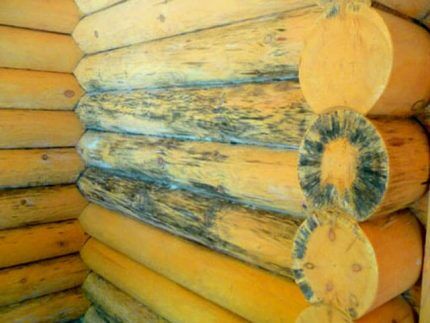
Fungi like the very common blue fungus completely change the color of wood. They feed on protein, starch, sugar and grow quite quickly - a spot can double in size in just 10 days. But for this, one condition is necessary - the moisture content of the wood is higher than normal.
Blue is not believed to affect strength characteristics, so spore-contaminated timber and lumber are often tested for suitability, and mold may be present in a batch of lumber intended for renovation work.
The most dangerous fungus for wood is putrefactive fungus. It feeds on the fibers of the material, breaking them down with secreted enzymes. First, bright brown spots appear on the surface of boards and logs, and after a few weeks or months the wooden elements become unusable.
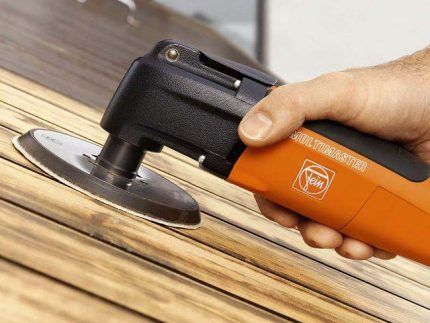
Sometimes the process of development of the hearth occurs secretly: several subtle stains appear on the upper part, but active destruction occurs inside. “Sick” parts of the cladding or frame can be recognized by a dull knock. A durable-looking timber, affected by rot, breaks when pressed.
Mold is harmful not only to the wood itself, but also to people who inhale air contaminated with spores.If there are allergy sufferers in the house, they will always feel unwell when outbreaks occur. Small fungi are also dangerous for healthy people - they can provoke the occurrence or exacerbation of various diseases of the respiratory system.
The most vulnerable and susceptible to mold in a wooden house is bathroom or a shared bathroom. The shower room suffers in the same way, even if the box is perfectly sealed and does not allow drops of water to pass through.
Therefore, when installing hygienic rooms in buildings made of timber or logs, it is imperative to follow the technologies for their organization and use protective antiseptic agents.
Causes of wood destruction
Let's assume that the inside of the house was lined with absolutely healthy boards. However, over time, they also began to turn blue and gradually become covered with ugly stains. What does this come from?
Mold reproduces by spores that are present absolutely everywhere - in the forest, in the fields, on the roads. It is estimated that forest-dwelling species living on living trees cover approximately 40% of the surface area of the trunks and branches of these trees and shrubs. They do not destroy bark and other tissues, but make them more porous.
Spores are easily carried by wind, animals and even shoes. If microorganisms, by any of the listed methods, enter a house where favorable conditions have been created for them, they quickly begin to multiply. The ideal conditions for the existence of mold are high humidity (from 70%) and temperature from +5ºС to +30ºС.
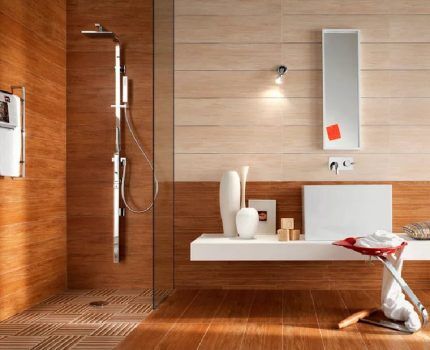
Wood is just one of the materials on which entire colonies of fungi settle. They can grow on rubble stone, concrete, plaster, paper and even plastic.
Owners of seasonal country houses in central Russia know very well: if you do not regularly heat a wooden house or do not take care condition of the basement and foundation, then dark spots will definitely appear in the corners, on the ceiling and even on the furniture.
The same problem threatens cellars and wooden baths if ventilation is not organized in them. Even the interior lining of the clapboard can become infected with fungus and become completely unusable if it does not have the opportunity to ventilate and dry out.
The lack of air circulation also favors the rapid growth of mold colonies. This can be seen in city apartments, where bathrooms are lined with wood panels and ventilation is poor.
If the surface of the panels is not treated protective composition, they will soon be covered with a light white or black coating, and over time the cladding will take on a neglected appearance.
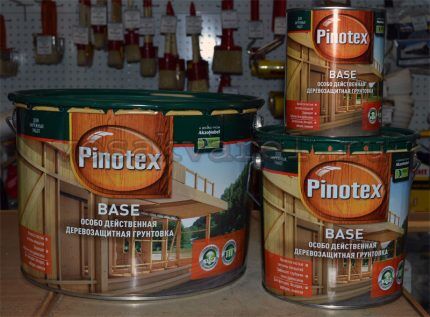
Thus, the reasons for the appearance of fungus or mold is the lack of waterproofing, ventilation problems, high air humidity.
DIY ways to solve the problem
If the causes of mold are not eliminated, even after its complete destruction, spores can enter the room and return the problem. Therefore, it is necessary to carry out a number of measures to eliminate favorable conditions for the growth of fungus, especially the most common of them - high humidity.
First steps to take:
- if the attic or basement is damp, it is necessary to consider hydro- and vapor barrier, check the integrity of the roof and the condition of the foundation;
- in case of air circulation problems, adjust ventilation or design a new, more efficient system, install forced air supply devices (fans);
- if conditions permit, ensure penetration of sunlight (relevant for verandas, terraces, balconies) - mold does not tolerate ultraviolet irradiation;
- during the repair process, along with wooden cladding, it is necessary to use a vapor barrier membrane to protect against condensation;
- check the condition of surfaces bordering the contaminated area;
- thoroughly warm and dry the room where new mold colonies periodically appear - a heat gun is suitable for this.
To summarize, it is necessary to carry out any possible measures to reduce humidity.
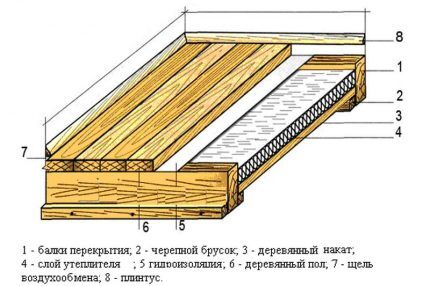
Let's look at how to get rid of mold on logs or boards using chemicals.
There are a number of solutions that can be purchased at a hardware or hardware store:
- Dali – suitable for concrete, tiles, wood, painted surfaces;
- Biotol spray – used for treating facades, cellars, attics;
- Alpa – antifungal agent for interior work;
- Stop Mold – a concentrated composition for treating the areas most susceptible to infection - basements, terraces, attics, greenhouses.
To use the product, you must remove visible mold, rinse the areas with clean water, after complete drying, apply an antiseptic solution in several layers.
You can get rid of a mold stain in a simple but labor-intensive way:
Traditional methods of getting rid of fungus
When using what are commonly called folk remedies, you need to remember three points:
- their use is often remembered when it is too late and more effective solutions are needed;
- It is difficult to remove overgrown lesions with household solutions, and when they are destroyed there is always a risk of new colonies appearing;
- When getting rid of mold, you need to simultaneously eliminate the causes that gave rise to it.
Let's look at the available products that you can find at home or buy.
Treatment with chlorine bleaches
Stores sell a solution that is traditionally called “Whiteness”. The compositions of different manufacturers may differ, but the main substance does not change - it is sodium hypochloride, a powerful antiseptic and oxidizing agent.
At chemical plants, it is used to disinfect water and various surfaces; in everyday life, it is used to bleach fabrics and disinfect bathrooms.
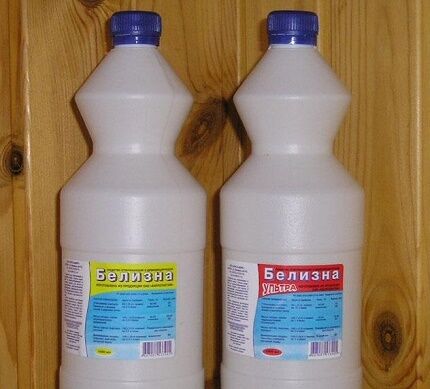
When using a solution, it is important to determine its concentration. Usually “Whiteness” is diluted with water in a ratio of 1:10, but to combat mold a more powerful antiseptic is needed, so the proportions change to 1:1.
Whiteness is ideal for smooth surfaces such as tiles or hard plastic. Wood has a porous texture, which is very difficult to process, so a chlorine solution is only suitable for removing external signs, stains and stains; it will not save you from deep penetration of fungus.
The concentrated composition is applied in several layers with a paint brush, then washed off with clean water. If the fire is in an inaccessible place (in the attic), the product does not need to be washed off.
Pharmacy antiseptic solutions
Hydrogen peroxide, which is used to treat wounds and scratches, also works great against fungus. As a rule, a small bottle of peroxide can always be found in the first aid kit, so nothing prevents you from doing a little experiment.
Moisten a cotton pad with a few drops of the solution and wipe the mold-affected wooden surface. If the stains disappear, you can process the already clean area several more times.
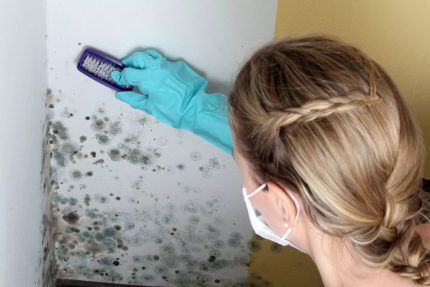
If you purchased a bottle of 3% solution, do not dilute it with water, this concentration is not considered strong. It is enough to apply peroxide to the damaged area and leave for a while, then repeat the procedure.
The second solution “from the pharmacy” is ammonia, which is included in products for cleaning windows and washing the print heads of inkjet printers. It also works effectively on smooth surfaces (glass, earthenware, plastic), and with moderate success on wood (or plasterboard).
The procedure should be carried out according to the same rules as with “Belizna”: dilute in a 1:1 ratio, do not forget to wear gloves and a respirator.
The use of "kitchen" products
At least two products used to combat mold can be found in your kitchen cabinet. This is vinegar and soda.
Vinegar, like Belizna, is not able to completely remove mold, but, unlike it, it is absolutely safe for humans. It is not diluted with water, but is applied in large quantities to the infected areas using a roller, brush or sponge.
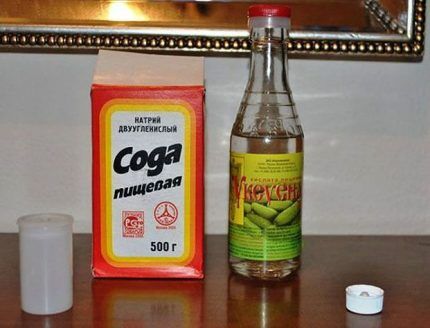
If the mold on a wooden surface resembles plaque, then there is a chance of getting rid of it completely. However, do not forget about the persistence of harmful microorganisms and wipe the areas at risk every 2 weeks - until you correct the ventilation and insulate the room.
Soda is also one of the safest remedies.It is often used for cleaning children's clothes and washing dishes. However, when paired with vinegar, it can destroy a small colony of mold. If you notice a scattering of small black dots on the walls, dilute baking soda in vinegar and wipe the infected area.
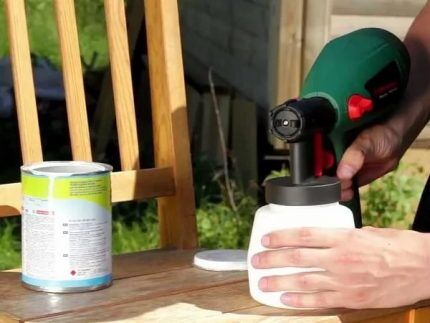
Soda does not harm wood, so this option is also possible: pour a small amount of powder onto a slightly dampened cloth and rub into the damaged area, and then rinse with water.
Overview of the antiseptic products market
When folk remedies are useless, heavy artillery enters the battle - highly effective chemical solutions that are used both for prevention (initial treatment) and for “treating” already damaged elements. Let's look at the popular antiseptics that can be found on the shelves of construction supermarkets.
Most of the products presented by modern manufacturers are universal. Their composition is such that it simultaneously protects the wood from rot, mold, sunlight, bugs and even fire.
Wood for the external cladding of a house, like all elements of decorative interior design, must be processed without fail, otherwise the risk of damage is very high.

Let’s name several manufacturers of antiseptics that are popular and regularly occupy the top lines of the ratings:
- Tikkurila. Known for a large range of multi-component impregnations that can protect wood in the most difficult conditions. Note the Valtti Pohjuste deep penetration primer and Vinha covering mortar. Tinted impregnation-glaze Valtti Color (Extra, Satin, Primer series) penetrates deep into wood fibers and does not form a film, as a result of which wooden products look natural.
- Senezh. The most reliable antiseptic is for deep impregnation, ideal for treating facades. It is not washed out by water and is able to protect wood in difficult weather conditions. Senezh Ecobio is designed for use inside the home, and Aquadecor was created specifically for decoration. There are many positive reviews about Senezh protective equipment for saunas and baths.
- Belinka. Suitable for processing internal and external wooden surfaces. BELINKA BASE contains a concentrated portion of biocides; BELOCID is suitable for both prevention and treatment of contaminated surfaces. BELINKA IMPREGNANT is a colorless impregnation, good where it is important to preserve the natural texture of the fibers.
- Aquatex. Perfectly protects logs, boards, lining, chipboards from mold and wood-boring beetles. Has more than 10 tinted options. The solution is used as a primer or impregnation.
- Neomid. A well-known Russian brand with a wide range of antiseptic products. NEOMID 440 ECO effectively protects wood products in rooms with high humidity, NEOMID 400 is used for processing interior parts, NEOMID 46 BiO protects lumber from mold damage.
The list can be continued with the names of alternative products: Dufa Wood Protect, Sitex, Pinotex, Texturol, Woodmaster.When using this or that product, you must act strictly according to the instructions.
Professional mold control
There is another effective method for removing an unpleasant “guest” - calling specialists.
They can do things that the residents of the house cannot do on their own:
- will diagnose the microclimate using high-precision instruments;
- analyze the condition of the affected objects;
- will conduct an examination and draw up a conclusion on the nature of the occurrence of mold on wooden surfaces;
- will select the most effective professional products and treat areas of fungal growth with biocides;
- They will neutralize indoor air using UV installations.
If necessary, professionals will carry out construction work: will increase ventilation efficiency, will reduce heat loss by laying insulation, and restore normal humidity by installing waterproofing.
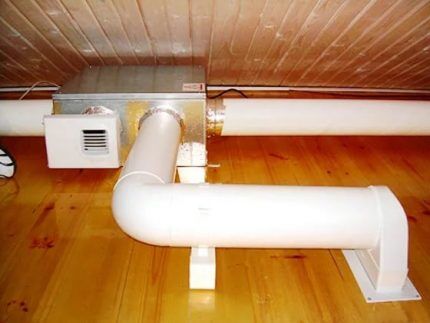
The main advantage of professional treatment of the room is the guarantee that mold will not bother you in the near future. The most responsible companies undertake to carry out repeated measures to eliminate newly emerging outbreaks.
If you decide to call a team of specialists, take care to document the order. The contract for the provision of services must include a warranty period and indicate a list of procedures performed. If workers carry out construction activities, they must be guided by the requirements of GOST and SanPiN.
Conclusions and useful video on the topic
Informative videos will help you choose a wood mold protectant and teach you how to use it.
Video #1. Valuable tips for choosing antiseptics:
Video #2. Application instructions from the düfa professionals:
You can protect wooden boards, logs or facing elements from mold yourself, but taking into account the recommendations of the manufacturer of special products and compliance with safety standards.
If you choose the right impregnation or decorative protection, the wood surface will retain its original appearance for a long time, and proper thermal insulation and effective ventilation will create conditions under which mold will never settle in your home.
Do you know an effective way to get rid of mold in addition to those we have given? Would you like to share your own experience in combating this very persistent biological phenomenon or would you like to ask a question? Please comment in the block below.




This misfortune has not spared us either. And one thing I definitely agree with is the ventilation device. We did this, and the mold began to spread much slower. But choosing a product took a long time. All traditional methods did not help (we tried vinegar, peroxide, etc. substances). Once I bought a product not for wood, but for the bath. The smell was merciless, but, oddly enough, it helped. I had to do the treatment twice, it stung my eyes. The mold has been washed off in some places. Afterwards we treated it with a preparation for wood. And, pah-pah-pah, mold has not made itself felt for six months now.
About three years ago, a fungus developed under the floor in the house, either because of flood water seeping in, or because of the general high humidity. The first thing, of course, was to make ventilation in the foundation. I simply opened the pipes on both sides, and to prevent the animals from entering the house, I sealed the holes with mesh.I treated the areas affected by the fungus with drying oil, and after 5 days I treated them again with a solution of soda and salt with boric acid (diluted by eye). Everything seems to be fine so far.
We have a wooden house under construction of 60 sq. m. m. We encountered the following problem: traces of mold appeared on the beams and walls. The infected areas were treated with a simple method - whitening. Almost half an hour later the tree turned white and became clean. The infection on the ceiling was more serious; the first time it was not possible to remove the unpleasant marks; it was necessary to go around it several times. The main thing is to buy white in such old Soviet packaging. In stores, wood bleaches are more expensive, and most have a similar composition to whiteness.